This is an intro to Bushido Risen Sun, the best miniatures skirmish game you’ve not yet played. If you’re looking for a balanced, impartial review, it will swiftly become clear this is not it. If you want a balanced and insanely fun competitive skirmish miniatures game in a fantasy setting with beautiful miniatures – then read on. While this is not a true ‘historical’ game, the historicals team have been kind enough to offer this content a home [Ed’s note: you’re welcome, buddy]. This is the first in a series of articles about this game.
Disclaimer – I am not being paid or otherwise compensated by GCT Studios, the company behind Bushido Risen Sun. I don’t claim to represent the extremely diverse and helpful community growing around the game, some of whom I hope to enlist in future articles, and many of whom have helped by providing images. Bushido is a relatively complex game, and I’m bound to get stuff ‘wrong’ below (let me know in the comment section). I enjoy this game and want even more people to play it with, and there’s no better way to reach gamers than this fine site.
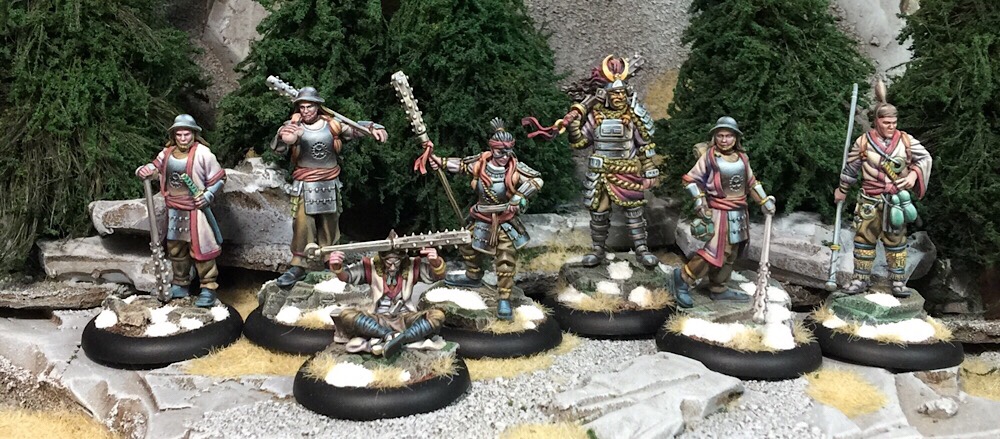
Image source: https://gctstudios.com/content/welcome-bushido-0
What Is This Game?
Bushido is a 1 vs 1 competitive dice and miniatures game with awesome mechanics. It has a thriving (and very welcoming) competitive and casual community. There are experimental solo and 3+ player rules, but to really enjoy Bushido you’ll need to find someone to play against. Bushido is growing fast, and the Discord has local sections for this very purpose.
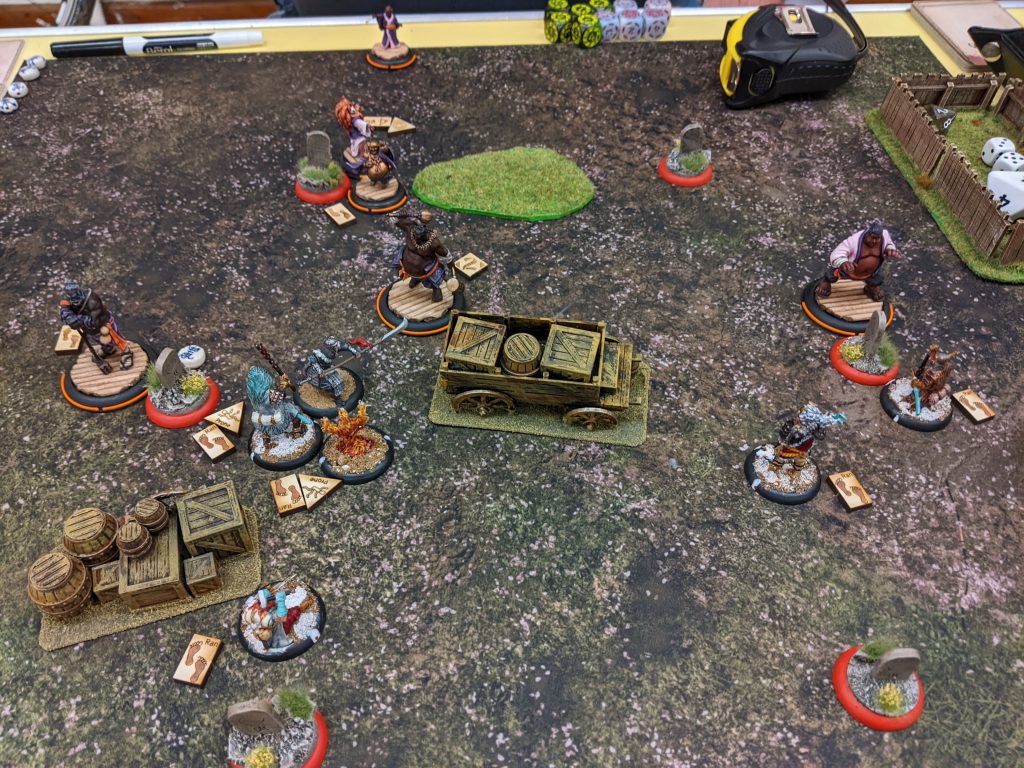
Games take place on a 2×2 foot board, usually involving around 6/7 models per player. The turn structure is based on alternating activations: this means each player takes turns to activate one of their models. Each model gets two activations per turn as standard. Games usually take around two hours, or at least are mostly decided within that time, and play out over five or six turns on the twelve or so core scenarios.
The designers are active on the Discord, sharing playtests, updates, clarifications and errata’s frequently with the community. They’re responsive, friendly, and helpful, as are the other players I’ve encountered. New models are released about every quarter, and errata, updates and fixes come in as and when the community playtests, feedback and tournament results indicate it might be a good idea.
Miniatures and Getting Started
The 32mm truescale minis are beautiful sculpts (with some older exceptions) and mostly white metal or resin. (For some incredible paint jobs check out @heddlycoppock.) Each model has a profile card included in the pack, but all cards, rules, and updates to rules are also available online at the time of writing via the excellent, free, volunteer created and managed Bushido Companion app for Android and IOS. (Link here). For list building, Battlescribe files are regularly updated and a bespoke listbuilder has also been developed.

There is a handy starter set containing two complete Ronin lists (including the beautiful minis above), tokens, cards and a 100 page rulebook for £70. There are also starter sets for each of the factions, and boxes for some sub factions. At time of writing, most individual models are priced at around £10 each, but the faction starter sets usually contain 5-7 models and cost around £40 (though don’t contain rules books or tokens). The rulebook is £18. This is a game it’s very possible to get into, competitively, for around £100.
The terrain is a hobbyist’s dream, because there is almost no official terrain; instead most gamers create their own sets. Most games need a pool of around 8-10 pieces, ranging from small (30mm base) like a shrine or lantern to large (50mm base) like a pile of crates, or even bigger (about 3” by 4”), like a small hut. Terrain is deployed alternately from a communal pool by each player before models are deployed.

The World and Lore
The world of Bushido Risen Sun is a Japanese folklore-inspired fantasy world of skilled samurai, sneaky ninjas, powerful monks, terrifying Oni, Tengu, and Kami, masterless Ronin and more. Action takes place on the Isles of Jwar, with different factions striving to dominate or destroy each other for their own, often cryptic ends.
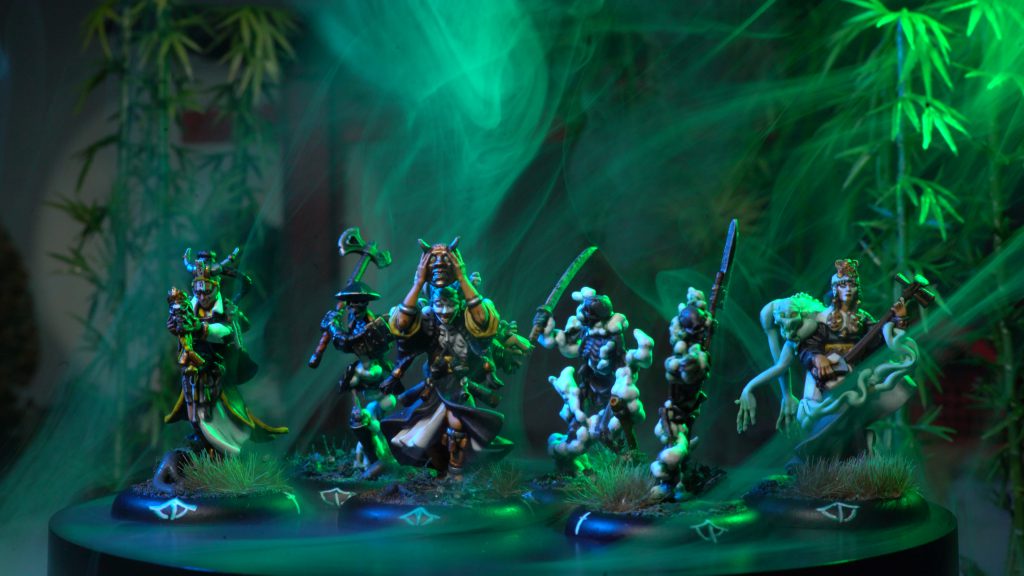
These ends are shrouded in mystery, not least because much of the lore exists only in the minds of the designers – though a full lore book is apparently forthcoming. Lore is actively influenced by the tournament scene, and the positions of the overall factions and even individual model profiles have changed across editions due to the actions of players at scale, which I love. At time of writing, Grand Masters tournament winners and top placed players even get to design their own profiles and cards to add to the ever expanding universe.
Factions and List Building
The currency of Bushido is rice. Most games are fought at a value of 100 rice, meaning each player chooses models, events and equipment from that total.
There are twelve core factions, most with sub factions, and Ronin too, most of which are also tied to only a few factions themselves. To build a list, you choose a faction first. This gives you a pool of faction models, aligned Ronin, themes, special event and equipment cards to choose from.

To give you some idea of how it breaks down – an elite, top tier model for a faction with a list of abilities and a powerful profile might cost 25-30 rice. In this bracket fit ninjas capable of murdering Daimyos, giant grizzly bears, vast Oni that can swing Torii arches or giant bells as clubs, the most skillful samurai in the land, and powerful casters capable of mind-controlling their opponents or summoning a wave of shambling undead.

A staunch, well-equipped samurai or a skilled monk might cost around 18-22r. A mercenary falconer, a cannon/musket wielding sniper, or giant half-shark, half-human with a tendency to go berserk might sit around the 15r mark. Peasants, Ashigaru, local troops, deck hands and acolytes cost around 5-12r and rats, eagles, trained dogs or horseshoe crabs (the most busted model in the game, come at me Jung fanciers) cost a couple of rice or less.
This tremendous variety means it’s possible to bring very different feeling and playing lists in most factions, and play very different ways simply by changing part of your list. The power of the most elite models can be curbed by feeding them cheap chaff, stripping their activations. Or standing back and shooting at them.
Scir_Waeter’s Example Minimoto List
Minimoto are my primary faction right now (also a good faction for beginners). I’m taking this list to a local tournament. It’s very unsubtle. It likes to hit people, tank damage, then hit them again. I’ll share more lists from recent tournaments from different factions (and better competitive players) in future articles.
Faction: Minimoto
Every list you build needs an aligned faction, even if the only models you use are Ronin. This enables the designers to balance things and stop (most) truly janky combinations.
Theme: The Finest Steel
Theme benefits do cool stuff, but they usually restrict your model pool. This one makes your models even more durable. You don’t have to use themes, and it’s possible to be very effective without themes.
Hoshi Odamu, 21 Rice (£9.84)
Enhancement – Teachings of Yashushi, 2 Rice
Enhancements give your models special abilities and are attached to a specific model in list building (sometimes in game).
Minimoto Yuji, 20 Rice (£9.84)
Minimoto Niko, 18 Rice (£9.84)
Minimoto Reo, 17 Rice (£9.84)
Enhancement – Aspect of the Bear, 2 Rice
Minimoto Kajiya, 9 Rice (£9.84)
Kami of the evening Flame A 8 Rice (£12.05 for 2)
Event Cards:
Just a Scratch x2, 4 Rice
Hasty Bear, 1 Rice
Event cards also do cool stuff. Just a scratch allows you to half damage done to you, then it is discarded. Hasty Bear lets me access a special ability I’d normally only get if I’d taken four wounds on a model.
Total: 100 Rice.
Models, £61.25 (with 1 extra kami you’re not using in this list). The faction card pack costs £10.95. Official token set £8.95. Rule book £18.00. I’m going to assume you have enough D6 and measurement widgets already. Use someone else’s terrain and mat. Total £99.15.
Factions
The factions of Bushido Rising Sun are worthy of an article in their own right, so I’m not going to go into much detail here. Instead I’ll top-line a bit about each of them to give you a flavour for who they are and how they (usually) play. There’s a dedicated Discord channel for each of them, and they all have passionate advocates and detractors. You’ll also find some nice background in the rulebook and on the GCT site.

The Prefecture of Ryu
Current rulers of the Jwar Isles. Proud samurai, tactical geniuses, skilled swordsmen and women, musket or spear armed ashigaru, and the occasional dragon. Mostly well-armoured and closely affiliated with the Emperor. A good faction for beginners with enough depth to be competitive on the tournament scene too. If you want to feel like the samurai faction from The Last Samurai start here.
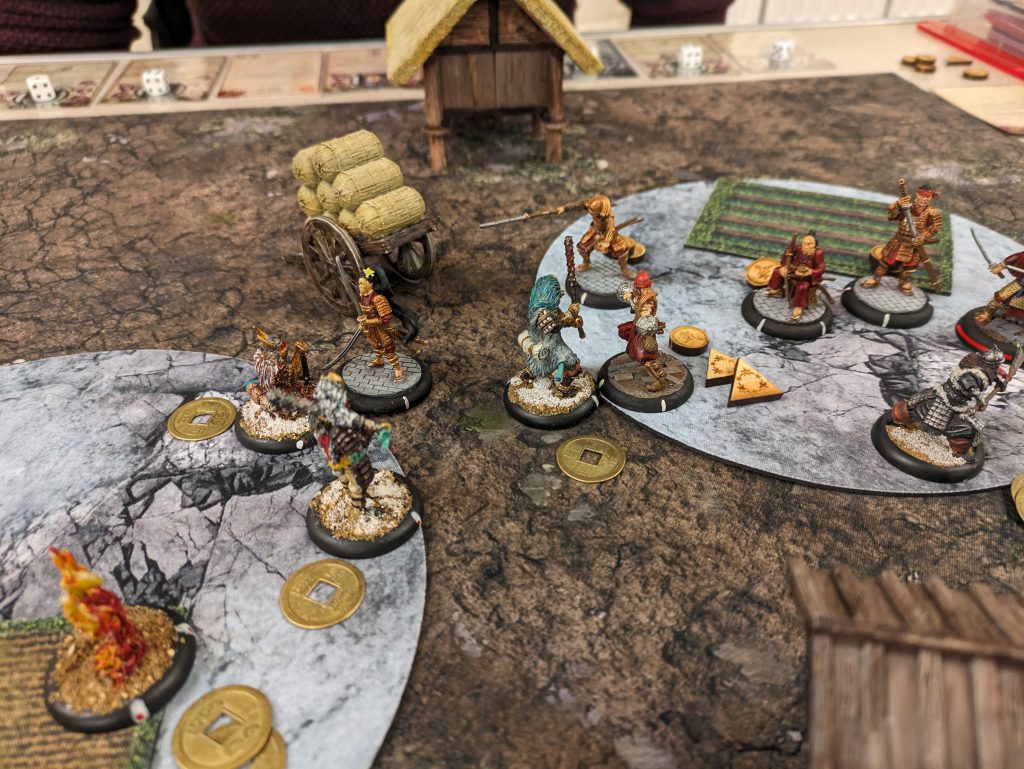
The Ito Clan
Snake samurai from the jungles. Their priests have made a dodgy deal with a serpent god that gives them great powers, mostly involving poison, but which has a tendency to turn parts of their body into snakes. Typically a glass cannon faction: Great archers, witches and sword masters who move fast and hit incredibly hard but die easily with a lower health pool. If you like the idea of shooting snakes at people and subduing them with poison, start here.
The Minimoto Clan
The Bear clan, with heavy armour, large tetsubo (clubs), superb samurai, ashigaru, blacksmiths, armoured lethal frisbee throwers, ice witches and trained fighting bears. Hailing from the mountains, this faction has one approach to every problem: Smashing it in the face while sucking up punishment. Very high damage output, heavy armour and lots of damage reduction makes this a forgiving faction to play and a good place for beginners to start, but low mobility (and usually low model count) means it can be at a disadvantage on certain missions. Despite this, Minimoto usually places fairly well at tournaments.

The Shiho Clan
Former rulers of the Isles of Jwar, their drunken and disorderly Daimyo (a ronin model exists for his wilder years) has recently got his act together and shaped the wolves (thanks @hoshi, @skyballer) his clan into a terrifying force. A guerrilla faction, expert at hit and run and ambush attacks, but not fans of protracted melee (with a few notable exceptions). If you like the Lone Wolf and Cub/Zaitoichi aesthetic start here, though be warned: They can be unforgiving to play.
The Shadow Wind Clan
Ninjas. Low model count (many lists are around 4-5 models) lethal fighters who can hide behind a blade of grass and engage in all kinds of shenanigans involving smoke bombs, disguises, extra activations and surprising your enemies. If you’re the sneaky type who enjoys stabbing people in the back, start here. It’s possible to build some fairly simple, tough lists with House Bleeding Moon – probably the best place for beginners to start with ninjas, though sub-factions like Long Shadow can create the kind of beautiful clockwork death lists and sequences of interactions that also satisfy high skill players (if not their opponents).
Jung Pirates
Pirates! With half-shark and half-crab people in support, not to mention the odd sea god. Cannon, harpoons, anchors, boarding hooks, trickery and great low cost fighters buffed by their leaders. Usually one of the higher model count factions as they have access to some great chaff. Including the most busted model in the game, the 1r horseshoe crab.
Silvermoon Trade Syndicate
A totally legitimate (criminal) syndicate. Gangsters, gamblers, Kabuki actors and Buto/sumo wrestlers. Lots of gambling mechanics, trickery and disguise mechanics, as well as access to a menagerie of trained (and often lethal) animals. Another faction that rewards more complex list builders but with plenty of simple and tough list building options too.
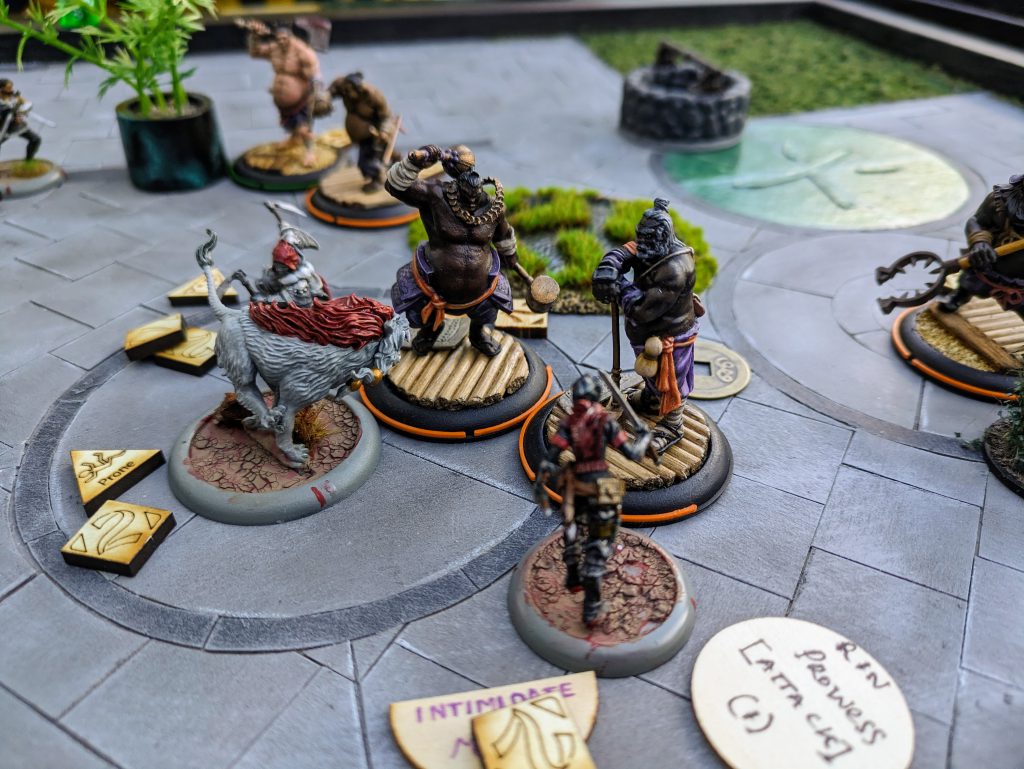
Cult of Yurei
The scary, spooky dark magic faction, including witches, zombies, durable skeletons, blood magic, and cultists. Some of these sculpts are truly nightmarish (in a good way). Play a shambling horde of of the dead led by one or two powerful casters, or a group of horrors plucked from the pages of nightmares. Lots of access to fear and ways of summoning reinforcements or mind controlling your foes.
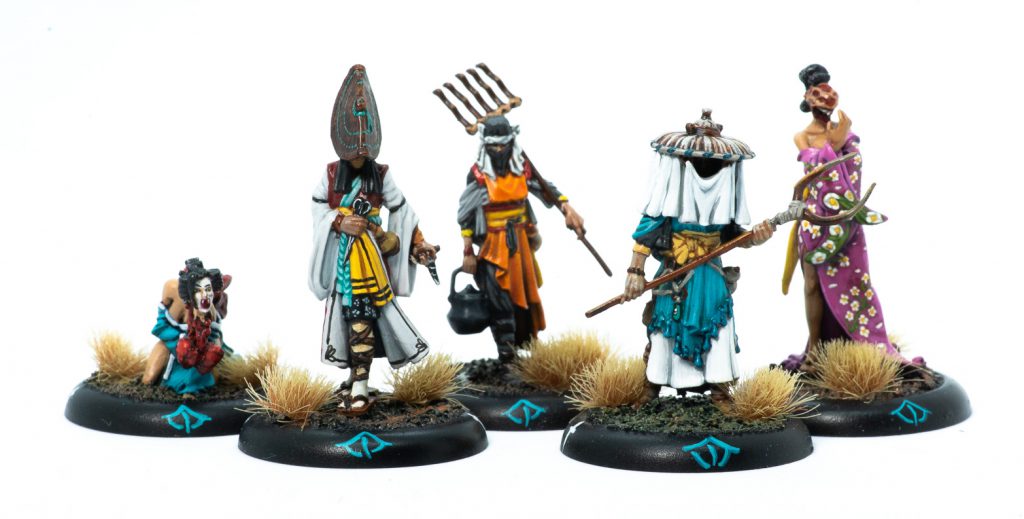
https://www.instagram.com/edchopp/
Savage Wave
Oni (like demons), Onisho (smaller demons) and Bakemono (like goblins), and a few brutalised human slaves. Can be played either as a relentless horde of tricksy Bakemono (including some with muskets) summoning more every turn, or a small band of elite, high wound pool berserker Oni with massive potential for damaging themselves and all others unfortunate enough to get in their way, or a combination of the two.

Descension
Tengu (bird people), the wild tribespeople that support them…and eagles. Lots of eagles. This faction moves and flies around the board at pace – but does not want to get bogged down in combat. Probably something to do with those light bird bones.
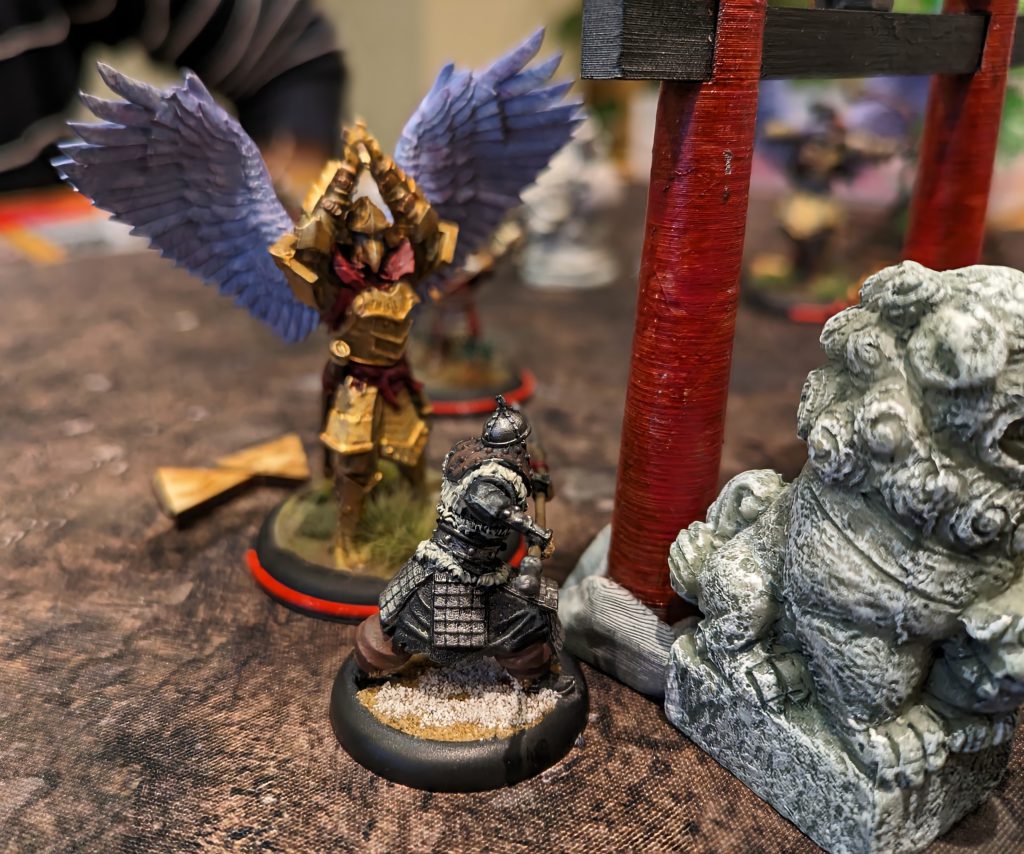
Temple of Ro Kan
Monks, Kitsune (fox people), villagers, and a staff-wielding panda. This faction has the broadest set of profiles and variety of playstyles available, with elite beaters capable of taking on anyone, horde lists and extreme magic/ki based gimmicks. This has made it the go to for the most competitive players in the bushido community. After a few too many back to back tournament wins, some of the most powerful profiles and theme benefits have been nerfed. Still a rewarding and very popular faction to play with a beautiful range of miniatures. Many profiles get Kata- a trait restricted to monks or those trained by them that means they don’t discard rolls of one.
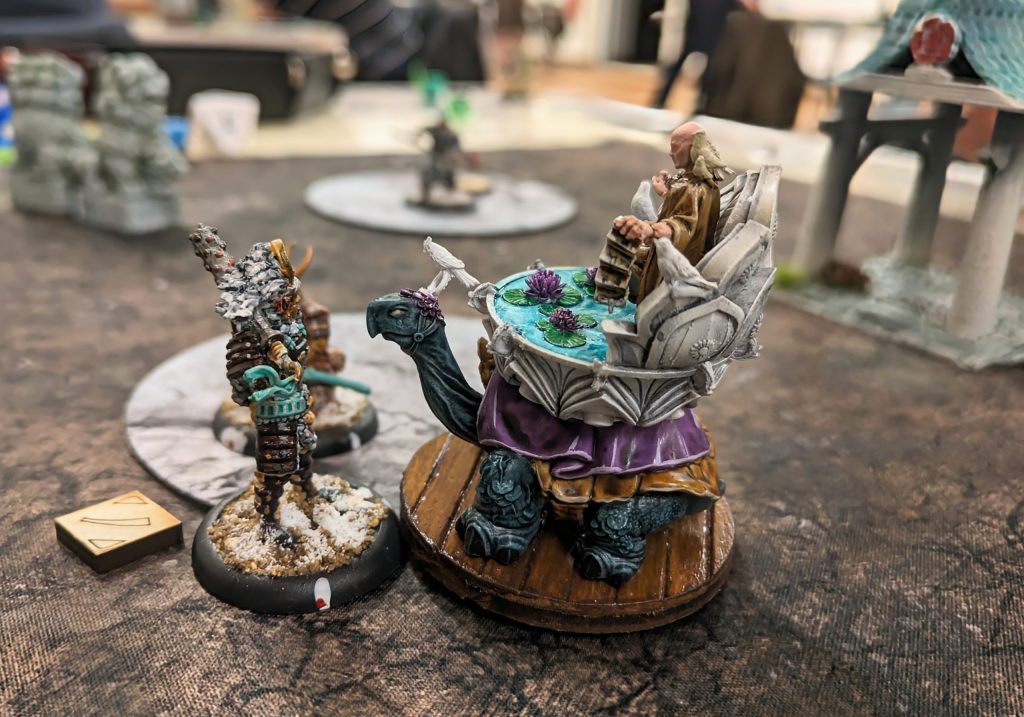
Kinshi Temple
The ‘other’ monks – void monks. Emo monks who wear a lot of black. If the temple of Ro Kan want to embrace the life force of the universe (ki), the Kinshi temple seek to eradicate it completely. Their faction symbol is a black hole. Go figure. This is the newest faction in Bushido, and so far has only nine faction specific models. They play weirdly too. Not the best pick for beginners in my view, but a growing following in the community.
Mechanics
“So what are these awesome mechanics of which you speak?” This is a deep and rich game, so I’m not going to be able to explain them all here… but I’ll do my best with the juiciest. GCT has a great series of explainers for those who like more visual explanations (props to Edward Neale-Scullion) that do a better job than any text.
Whenever a model tries to do something that might happen or not, they roll a ‘test’ using a number of D6. The value they end up with usually depends on their profile, or the profile of the model opposing them.
Say I roll four dice for an opposed test, rolling a five, three, one and a one. All rolls of one are discarded (unless you have kata, but forget that for now). My highest value remaining is five. The three becomes a supporting dice, and adds +1 to my five, giving me a total of six. Supporting dice are capped in Bushido Rising Sun – only two count towards the final total, meaning the maximum achievable is (usually) eight.
So far so good. However, when it comes to melee tests – a form of ‘opposed test’ – the game really comes alive with fiendish bluffs, tricky attacks and magical boosts.
Say I’m a powerful Minimoto Samurai, wielding a large Tetsubo. My melee stat is 4. This is really strong; it means I have a pool of four dice to choose from. I’m facing off against one of the sneaky snake samurai of the Ito clan – slightly less-skilled in this case and more lightly armoured with a melee pool of three dice. Ito are known to have poisoned blades, so even a flesh wound can be deadly.

The genius of Bushido Risen Sun is that to represent the mind games of dueling, players can secretly choose how they allocate their dice from that pool of dice between defence and attack. Traits and feats can also change the initiative order, which determines whose attack happens first, or reduce dice pools by surprising, stunning or otherwise interfering with your opponent.
So my chunky Minimoto can choose to create any combination of dice – from all four in defence to all four in attack, with the option to choose a special attack or defence. Here the Minimoto player might choose to allocate three dice to attack, using a stun attack, and one in defence as insurance. The Ito samurai player has the same options, but one less dice to allocate. They might decide to put two in defence but risk putting one in attack, gambling that their defence will be enough.
This brilliant mechanic means it’s very rare to feel you have no hope or chance of influencing an outcome. Even as the defending player there’s a chance to kill, poison, sidestep, throw or any one of many specialist attacks or defences. Get too cocky in attack – and you end up dead. These mind games, and the jeopardy of the roll make up some of the most entertaining parts of every bushido game.
My Minimoto samurai rolls a four, three, and a one in attack, and a one in defence! Terrible roll.
The Ito samurai rolls a five and a four in defence, and a six in attack.
Remember ones are removed. If nothing changes, the Minimoto Samurai has a total of five in attack (four + one supporting dice) against the Ito’s six in defence (five + one supporting dice). Not enough, so the Ito samurai will have defended successfully. Now we might resolve the Ito’s attack. A six against the Minimoto’s defence of zero after the one is removed! This would lead to a success level of six in attack for the Ito samurai.
But these are samurai. They don’t get there by being easy to kill. To represent this, most samurai have a trait called ‘Prowess (Melee 1)’ This means they can choose one dice to re-roll out of their melee pool, before removing any dice. The Ito player is the defender, so decides first – but has rolled well so elects not to re-roll.
My Minimoto re-rolls his one in defence, and gets a four. Much better. You subtract the defence result from the attack. Despite being the defending model in this melee exchange, the Ito has successfully attacked with a success level of six – four = two, and we move to a damage roll, resolved by rolling 2d6 and adding them normally, referencing against Bushido’s damage table, subtracting armour and adding weapon strength to the result.
This may seem like a lot, but melees are typically resolved within 20-30 seconds once you’re up on the rules. It’s fast, full of jeopardy and very exciting, every time. In addition, most models in the game do not have prowess, meaning combat is usually even faster and more deadly. Exhausted, prone, surprised or stunned models also lose dice…meaning they become ever more vulnerable. Rolling ones in defence is often lethal, as even a success level of two can inflict up to five wounds. Most profiles have only five wounds.

The End, Nearly
Hopefully this has captured your interest enough to want to find out more about this great game. All being well, I’m hoping to enlist more expert contributions from leading players, painters, community members and content creators in the future.
If you’re hungry for more and can’t wait for the next article to drop, the discord is here discord. The Facebook page is here. GCT studios site (it’s a bit clunky, and being redone) is here . Products are sold direct from the GCT site, and a growing list of retailers including Element Games in the UK, Fireforgedminis.com and Noble Knight Games in the USA and MinaturicuM in the EU.
Thanks to the First Founding games club gang for taking me in, teaching me the game and allowing me to share their miniature paint jobs, and to Bair for the invite to write.
Have any questions or feedback? Drop us a note in the comments below or email us at contact@goonhammer.com.


